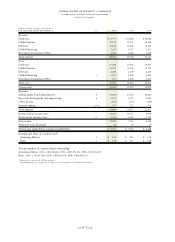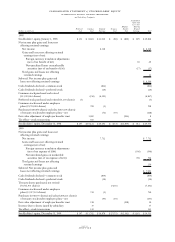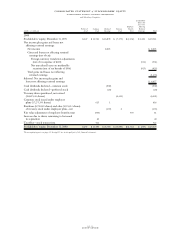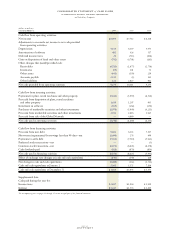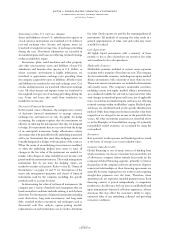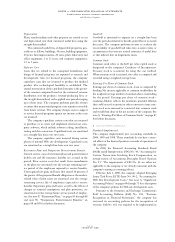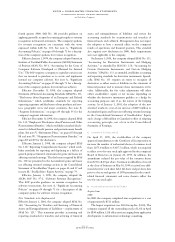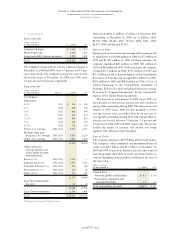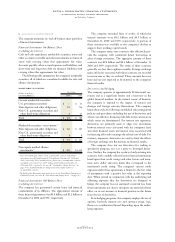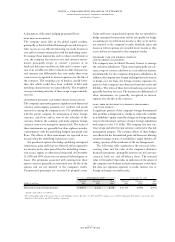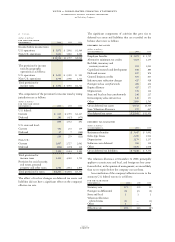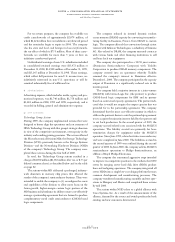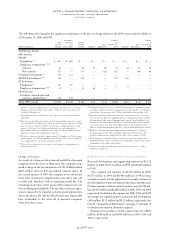IBM 2000 Annual Report Download - page 74
Download and view the complete annual report
Please find page 74 of the 2000 IBM annual report below. You can navigate through the pages in the report by either clicking on the pages listed below, or by using the keyword search tool below to find specific information within the annual report.
fourth quarter 2000. SAB No. 101 provides guidance on
applying generally accepted accounting principles to revenue
recognition in financial statements. The company’s policies
for revenue recognition are consistent with the views
expressed within SAB No.101. See note A, “Significant
Accounting Policies,” on pages 69 through 71 for a descrip-
tion of the company’s policies for revenue recognition.
Effective January 1, 1999, the company adopted American
Institute of Certified Public Accountants (AICPA) Statement
of Position (SOP) No. 98-1, “Accounting for the Costs of
Computer Software Developed or Obtained for Internal
Use.” The SOP requires a company to capitalize certain costs
that are incurred to purchase or to create and implement
internal use computer software. See note A, “Significant
Accounting Policies” on pages 69 through 71 for a descrip-
tion of the company’s policies for internal use software.
Effective December 31, 1998, the company adopted
Statement of Financial Accounting Standards (SFAS) No. 131,
“Disclosures about Segments of an Enterprise and Related
Information,” which establishes standards for reporting
operating segments and disclosures about products and serv-
ices, geographic areas and major customers. See note X,
“Segment Information,” on pages 89 through 93 for the
company’s segment information.
Effective December 31, 1998, the company adopted SFAS
No. 132, “Employers’ Disclosures about Pensions and Other
Postretirement Benefits,” which establishes standard disclo-
sures for defined benefit pension and postretirement benefit
plans. See note V, “Retirement Plans,” on pages 85 through
88 and note W, “Nonpension Postretirement Benefits,” on
pages 88 and 89 for the disclosures.
Effective January 1, 1998, the company adopted SFAS
No. 130, “Reporting Comprehensive Income,” which estab-
lishes standards for reporting and displaying in a full set of
general-purpose financial statements the gains and losses not
affecting retained earnings. The disclosures required by SFAS
No. 130 are presented in the Accumulated gains and losses
not affecting retained earnings section in the Consolidated
Statement of Stockholders’ Equity on pages 66 and 67 and
in note M, “Stockholders’ Equity Activity,” on page 79.
Effective January 1, 1998, the company adopted the
AICPA SOP No. 97-2, “Software Revenue Recognition.”
This SOP provides guidance on revenue recognition for
software transactions. See note A, “Significant Accounting
Policies” on pages 69 through 71 for a description of the
company’s policy for software revenue recognition.
New Standards to be Implemented
Effective January 1, 2001, the company adopted SFAS No.
140, “Accounting for Transfers and Servicing of Financial
Assets and Extinguishments of Liabilities
—
a replacement of
SFAS No. 125.” This statement provides accounting and
reporting standards for transfers and servicing of financial
assets and extinguishments of liabilities and revises the
accounting standards for securitizations and transfers of
financial assets and collateral. Management does not expect
the adoption to have a material effect on the company’s
results of operations and financial position. This standard
also requires new disclosures in 2000. Such requirements
were not applicable to the company.
On January 1, 2001, the company adopted SFAS No. 133,
“Accounting for Derivative Instruments and Hedging
Activities,” as amended by SFAS No. 138, “Accounting for
Certain Derivative Instruments and Certain Hedging
Activities.” SFAS No. 133, as amended, establishes accounting
and reporting standards for derivative instruments. Specifi-
cally, SFAS No. 133 requires an entity to recognize all
derivatives as either assets or liabilities in the statement of
financial position and to measure those instruments at fair
value. Additionally, the fair value adjustments will affect
either stockholders’ equity or net income depending on
whether the derivative instrument qualifies as a hedge for
accounting purposes and, if so, the nature of the hedging
activity. As of January 1, 2001, the adoption of the new
standard results in a net-of-tax increase of $219 million to
Accumulated gains and losses not affecting retained earnings
in the Consolidated Statement of Stockholders’ Equity
and a charge of $6 million to Cumulative effect of adopting
accounting principle, net of tax in the Consolidated
Statement of Earnings.
CCOMMON STOCK SPLIT
On April 27, 1999, the stockholders of the company
approved amendments to the Certificate of Incorporation to
increase the number of authorized shares of common stock
from 1,875.0 million to 4,687.5 million, which was required
to effect a two-for-one stock split approved by the company’s
Board of Directors on January 26, 1999. In addition, the
amendment reduced the par value of the common shares
from $.50 to $.20 per share. Common stockholders of record
at the close of business on May 10, 1999, received one addi-
tional share for each share held. All share and per share data
prior to the second quarter of 1999 presented in the consol-
idated financial statements and notes thereto reflect the
two-for-one stock split.
DACQUISITIONS/DIVESTITURES
Acquisitions
2000
In 2000, the company completed nine acquisitions at a cost
of approximately $511 million.
The largest acquisition was LGS Group Inc. (LGS). The
company acquired all the outstanding stock of LGS in April
for $190 million. LGS offers services ranging from application
development to information technology consulting.
notes to consolidated financial statements
international business machines corporation
and Subsidiary Companies
page no.
seventy-two




